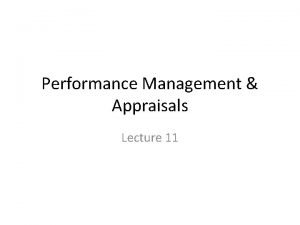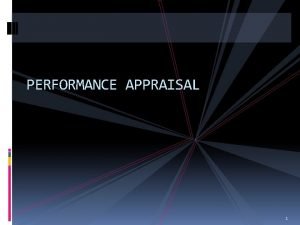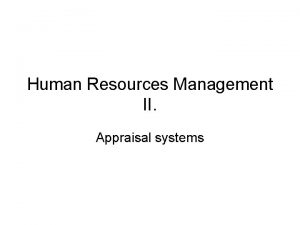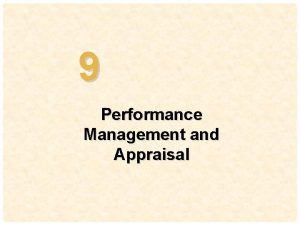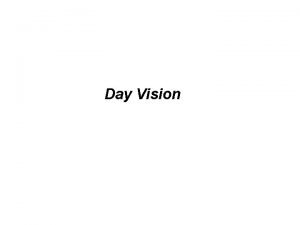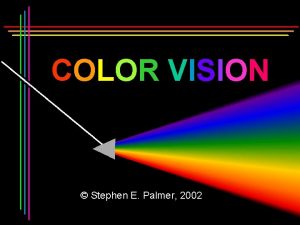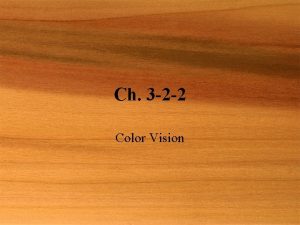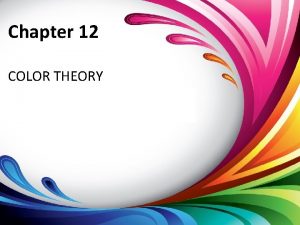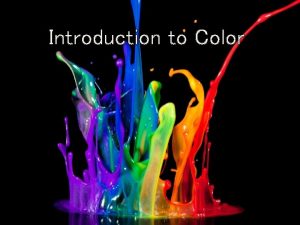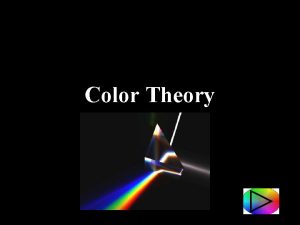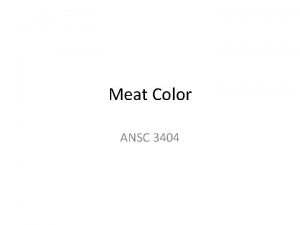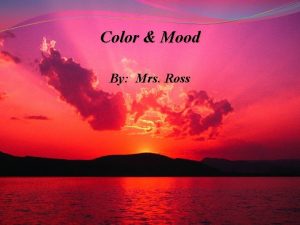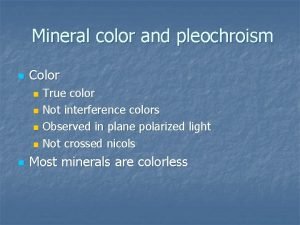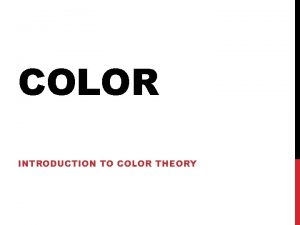A Performance Comparison of Color Vision Tests for


















































- Slides: 50

A Performance Comparison of Color Vision Tests for Pilots Requirement Marie Marechal

Conflicts of interests : None

Introduction Color-deficiency 9 % of men and 0. 5 % of women Protanomalous trichromats Anomalous trichromats Deuteranomalous trichromats Tritanomalous trichromats Protanopes Dichromats Deuteranopes Tritanopes S cone monochromatism Achromatism

Introduction Color use in aviation PAPI (Precision Approach Path Indicator) is the more critical Other are less problematic : Parking lights Taxiways Regulatory lights of airplanes.

Introduction Color is more and more present in cockpits, "glass cockpits“ : LCD screens with electronic process of many instruments of flights, whose display is multicolored. Colors choice : free to the manufacturer

Introduction - rules In France : Decree of 27 January 2005 and follow EASA regulations - pass the Ishihara 24 plate test Normal (first 15 plates identified without error or hesitation) - ‘normal trichromat’ at the Nagel anomaloscope Color vision - identification without mistake or hesitation of colored lights in Beyne lantern (presented at 5 meters for 1 second with 3 minutes of arc aperture) - matching range is 4 scale units or less to the Nagel anomaloscope Color vision Safe

Introduction - rules In France : Decree of 27 January 2005 and follow the EASA regulations - pass the Ishihara 24 plate test (first 15 plates identified without error or hesitation) - ‘normal trichromat’ at the Nagel anomaloscope - identification without mistake or hesitation of colored lights in Beyne lantern (presented at 5 meters for 1 second with 3 minutes of arc aperture) - matching range is 4 scale units or less to the Nagel anomaloscope Normal Color vision Safe Secondary tests in other countries In UK : Holmes-Wright lantern or CAD test In Germany : Anomaloscope In USA : Farnsworth and Optec lanterns, Titmus vision test, Cone Contrast Test In Canada : lantern test or Farnsworth D 15 In New Zeland : Farnsworth and Holmes-Wright lanterns, Farnsworth D 15 or CAD test

Introduction Lanterns : no more commercialized (only Fletcher-Evans CAM lantern) Aim of the study To assess the abilities of 8 color vision tests for screening and quantifying red / green hereditary deficiency.

Methods Prospective study Percy military Hospital, in Clamart (France). INCLUSION Color-deficient subjects: addressed for a failure in reading the Ishihara Color vision normal subjects : healthy volunteers. EXCLUSION BCVA less than 6/10. Sunglasses or tinted contact lenses. Ophthalmologic pathology (evolutionary or sequelar).

Methods - color vision test Ishihara Beyne lantern Fletcher lantern Farnsworth D 15 Arrangements test Lanthony 15 Hue Munsell 100 Hue CAD (Colour Assessment and Diagnosis) test Anomaloscope Nagel type

Methods - color vision test Ishihara 38 plates Out of order at 70 cm of distance, at 45° 3 seconds for each plate successful if the first 17 plates were viewed without error or hesitation.

Methods - color vision test Ishihara Beyne lantern Fletcher lantern Farnsworth D 15 Arrangements test Lanthony 15 Hue Munsell 100 Hue CAD (Colour Assessment and Diagnosis) test Anomaloscope Nagel type

Methods - color vision test Beyne lantern type aviation simple colored lights, in random order any hesitation or false answer = an error 2 protocols without cited colors military 1/25 th s / 2 : presentation 1/25 th second with 2 minutes of arc aperture 1 s / 4’ : presentation 1 second with 4 minutes of arc aperture 2 protocols with colors cited (red, green, blue, yellow-orange and off-white) civilian 1 s / 3’ : presentation 1 second with 3 minutes of arc aperture 1 s / 3’ x 3 presentations (pass if no error on 2 of 3 presentation)

Methods - color vision test Ishihara Beyne lantern Fletcher lantern Farnsworth D 15 Arrangements test Lanthony 15 Hue Munsell 100 Hue CAD (Colour Assessment and Diagnosis) test Anomaloscope Nagel type

Methods - color vision test Fletcher-Evans CAM lantern two lights, vertically 5 colors : 2 Red, 2 Green, 1 White 9 combinations Informative phase : colors presented and cited 'red', 'green' and 'white ‘. test phase : 0. 9 minute of arc , 2 seconds First round : pass if no error Two more rounds if errors

Methods - color vision test Ishihara Beyne lantern Fletcher lantern Farnsworth D 15 Arrangements test Lanthony 15 Hue Munsell 100 Hue CAD (Colour Assessment and Diagnosis) test Anomaloscope Nagel type

Methods - color vision test Arrangement tests Farnsworth D 15 to classify the 16 pawns in a time of 3 minutes. successful if no confusion right (circular scheme) a straight between the pawns 7 and 15, a simple pawns inversions. Desaturated Lanthony 15 Hue successful if less than 2 lines of confusion Farnsworth-Munsell 100 Hue 3 minutes /box x 4 axis of the deficiency severity score

Methods - color vision test Ishihara Beyne lantern Fletcher lantern Farnsworth D 15 Arrangements test Lanthony 15 Hue Munsell 100 Hue CAD (Colour Assessment and Diagnosis) test Anomaloscope Nagel type

Methods - color vision test The CAD Test (Colour Assessment and Diagnosis) Mesopic condition at 1. 40 meter in front of the viewing screen, 3 steps 'learning mode’ : check the test understanding. 'fast screening’ : identify a large part of the healthy subjects. ‘definitive CAD’ : determine the chromatic sensitivity of the subject present for each wavelength stimuli of varying intensity. determines the axis and severity according to a score (RG for the Red-Green axis and YB for blue-yellow axis) Healthy subjects : score < 2 SN Ability according to UK threshold : RG < 6 SN for protans and RG< 12 SN for deutans

Methods - color vision test Ishihara Beyne lantern Fletcher lanter Farnsworth D 15 Arrangements test Lanthony 15 Hue Munsell 100 Hue CAD (Colour Assessment and Diagnosis) test Anomaloscope Nagel type

Methods - color vision test The anomaloscope IF 2, Tomey Rayleigh equation, on the dominant eye in mesopic conditions 2 modes : Automatic or Manual identifies the deficiency axis, differentiates anomalous trichromats from dichromats, or class the subject in normal color vision 100 85 70 60 50 40 30 15 0 matching range severity Safe : if matching range less than 4 units at the Nagel anomaloscope 100 85 70 60 50 40 30 15 5

Methods 2 groups : CVD : color vision deficient CVN : color vision normal For each test, evaluation of : Sensibility, Specificity, Positive and negative predictive values Application to aeronautic : Total number and success ratio for class 1 ability Severity assessing : ROC curves for dichromatism diagnosis for CAD test and 100 Hue

Results 52 subjects 29 VCD 23 VCN p 23 years ± 6. 09 26 ± 6. 1 years p = 0. 075 0 woman 9 women p = 0. 015 - 11 deuteranomalous trichromats (37. 9%) - 7 protanomalous trichromats (24. 1%) - 6 protanopes (20. 69%) - 5 deuteranopes (17. 24%)

Results Detection of color-deficiency tests power

Results Detection of color-deficiency tests power

Results Detection of color-deficiency tests power

Results Detection of color-deficiency tests power

Results Detection of color-deficiency tests power

Results Class 1 ability for CVN • All subjects fit : anomaloscope, CAD test, 15 Hue • Ishihara : 2 subjects unfit • 100 HUE : 1 subject unfit (low discrimant) • Beyne lantern : 1/25 th s / 2’ : 11 fail on 23 (47. 8%) 1 s / 4’ : 1 fail 1 s / 3’ : all pass • Fletcher lantern : 5 subjects fail on first presentation, pass with retest

Results Total number and success ratio for a class 1 ability for CVD

Results Total number and success ratio for a class 1 ability for CVD

Results Total number and success ratio for a class 1 ability for CVD

Results Total number and success ratio for a class 1 ability for CVD

Results Total number and success ratio for a class 1 ability for CVD 0

CVD 1 Ishihara D 15 15 HUE Lanthony. Results 100 HUE BEYNE lantern FLETCHER lantern 1/4 1/25 th 2 1/3 3 tests 1 test 2 retests CAD test Anomal. fail fail PASS fail 2 fail PASS fail Fail fail PASS 4 fail PASS fail fail PASS 5 fail PASS fail fail fail 6 fail PASS fail fail fail 7 fail fail PASS fail 11 fail fail PASS fail fail 14 fail PASS fail fail PASS 15 fail PASS fail fail 16 fail fail PASS fail 17 fail PASS fail fail fail 20 fail PASS fail PASS fail 22 fail PASS fail fail 24 fail PASS PASS fail PASS 25 fail fail PASS fail 26 fail PASS fail 27 fail PASS fail fail 29 fail PASS fail fail PASS 30 fail PASS fail PASS 31 fail PASS fail fail

CVD 1 Ishihara D 15 15 HUE Lanthony. Results 100 HUE BEYNE lantern FLETCHER lantern 1/4 1/25 th 2 1/3 3 tests 1 test 2 retests CAD test Anomal. fail fail PASS fail 2 fail PASS fail Fail fail PASS 4 fail PASS fail fail PASS 5 fail PASS fail fail fail 6 fail PASS fail fail fail 7 fail fail PASS fail 11 fail fail PASS fail fail 14 fail PASS fail fail PASS 15 fail PASS fail fail 16 fail fail PASS fail 17 fail PASS fail fail fail 20 fail PASS fail PASS fail 22 fail PASS fail fail 24 fail PASS PASS fail PASS 25 fail fail PASS fail 26 fail PASS fail 27 fail PASS fail fail 29 fail PASS fail fail PASS 30 fail PASS fail PASS 31 fail PASS fail fail

CVD 1 Ishihara D 15 15 HUE Lanthony. Results 100 HUE BEYNE lantern FLETCHER lantern 1/4 1/25 th 2 1/3 3 tests 1 test 2 retests CAD test Anomal. fail fail PASS fail 2 fail PASS fail Fail fail PASS 4 fail PASS fail fail PASS 5 fail PASS fail fail fail 6 fail PASS fail fail fail 7 fail fail PASS fail 11 fail fail PASS fail fail 14 fail PASS fail fail PASS 15 fail PASS fail fail 16 fail fail PASS fail 17 fail PASS fail fail fail 20 fail PASS fail PASS fail 22 fail PASS fail fail 24 fail PASS PASS fail PASS 25 fail fail PASS fail 26 fail PASS fail 27 fail PASS fail fail 29 fail PASS fail fail PASS 30 fail PASS fail PASS 31 fail PASS fail fail

Results Deficit quantification AUC: CAD test 100 Hue : difference between achieved score and physiologic score 100 Hue : achieved score - 0, 98 [0, 94 ; 1, 01] for CAD test - 0, 65 [0, 47 ; 0, 83] for score difference in 100 Hue - 0, 69 [0, 52 ; 0, 86]for 100 Hue Best cut-off: - RG > 18, 5 for CAD test - Score difference > 22 - Score > 112 for 100 Hue

Discussion Squire et al. in 2005, UK 3 lanterns (Beyne, Spectrolux, and Holmes-Wright) and Nagel anomaloscope. 55 CVD subjects and 24 CVN subjects. all dichromats failed the 4 tests. pass one secondary test : not guaranteed to pass the other tests Tests authorized by the EASA standards : high variability and inconsistency of their results. Squire TJ, Rodriguez-Carmona M, Evans ADB, Barbur JL. Color vision tests for aviation: comparison of the anomaloscope and three lantern types. Aviat Space Environ Med. 2005 May; 76(5): 421– 9.

Discussion Fletcher in 2005 Similar to Holmes-Wright lantern : 2 lights with a 0. 9 minute arc aperture. BUT color used : slight differences in the CIE diagram. 9 / 71 normal trichromats : mistakes in first pass. 18 color-deficient subjects : all failed. Fletcher-Evans CAM lantern : very sensitive. good test for clinical diagnosis, not for chromatic selection. Birch in 2008 Holmes-Wright lantern type A 125 color-deficient subjects: 10 subjects (9%) were able to pilot Nevertheless, Fletcher lantern not comparable to the Holmes-Wright lantern (passing 9 to 30% of CVD) - Fletcher R. The Fletcher CAM lantern colour vision test. Optom Today. 2005 Jul; (29): 24– 6. - Birch J. Performance of colour-deficient people on the Holmes-Wright lantern (type A): consistency of occupational colour vision standards in aviation. Ophthalmic Physiol Opt. 2008 May; 28(3): 253– 8.

Discussion Walsh in 2016 , USA 65 CVD subjects and 68 CVN subjects of US Army. Our results : similar except a better diagnostic efficiency of the CAD test. Test Sensitivity Specificity CAD test 0. 86 0. 85 to 1. 00 Farnsworth D 15 0. 35 1. 00 PIPIC 0. 98 0. 96 to 1. 0 good efficiency of the computerized tests CCT and CAD operator-independent and randomized patterns Walsh DV, Robinson J, Jurek GM, Capó-Aponte JE, Riggs DW, Temme LA. A Performance Comparison of Color Vision Tests for Military Screening. Aerosp Med Hum Perform. 2016 Apr; 87(4): 382– 7.

Discussion British CAA, 2006 117 CVD Ability of PAPI lights recognition and CAD test results No subject who pass CAD test failed to PAPI simulator. (pass : RG < 6 SN for protan or RG < 12 SN for deutan) CAD test : pass in 36. 1 % of deuteranomalous trichromats 29. 8% of protanomalous trichromats In our study : only 18. 2% deuteranomalous trichromats 14. 3% protanomalous trichromats Barbur JL, Rodriguez-Carmona M, Evans S, Milburn N. Minimum Colour Vision Requirements for Professionnal Flight Crew. Recommendations for a new colour vision standards. Safety Regulation Group. Civil Aviation Authority; 2009.

Discussion New Zealand CAA, 2015 Decrease the requirements for color vision - Information coding multiple - colors choose to be recognized by CVDs PAPI simulator used by City University : not representative of real PAPI CAD test : too restrictive USA FAA , 2015 Color deficient subject : same recognition of PAPI lights as color normal - Brookes RE. Colour Vision Requirements for Aircrew [Internet]. New Zealand Defence Force. Dfence Technology Agency; 2015 [cité 16 août 2017]. Disponible sur: http: //www. dta. mil. nz/wp-content/uploads/Report 405. pdf - Milburn N, Gildea K, Perry D, Roberts C, Peterson L. Usability of Light-Emitting Diodes in Precision Approach Path Indicator systems by Individuals With Marginal Color Vision [Internet]. Civil Aerospace Medical Institute Federal Aviation Administration; 2014.

Discussion No learning Simple and reproductible Test protocol strictly respected and trained examiners can limit anomaloscope use Short time Ishihara, lanterns and 15 Hue : < 5 mn 100 Hue and anomaloscope : about 20 mn CAD test : < 5 mn if "Fast screening " + 8 mn for "Definitive CAD " : 6 CVN (26%), all CVD

Discussion CAD test Advantages Can’t be learn Reproducible Lanterns Advantages Quick Red / green and yellow / blue axis Easy 16 colors Less expensive Quantitative test Ergonomic test

Conclusion Many tests are used for pilots ability. Their results are discordant Ishihara : first intention test Lanterns are no more commercialized CAD test and anomaloscope : most accurate in our study Recent increase of colored signals in new generation cockpits. Multitude of color amount. Risk of not detected blue-yellow deficiency. The acceptable color-deficiency for a pilot to be safe is now to determine.

Thank you for your attention


Discussion In conclusion Ishihara plates : excellent screening test for red / green deficiency. Farnsworth D 15 : quick and easy but some dichromats subjects can pass this test. Lanthony 15 Hue test : ability of 20% and seems suitable for use in professional selection. Munsell 100 Hue : too long Fletcher-Evans CAM lantern : too restrictive Beyne lantern : simple and quick to use, but some dichromats pass. Anomaloscope : qualify and quantify the deficiency requires a strong experience of the examiner. CAD test : quantitative test , yellow/blue and red/green thresholds used by the British CAA seem to be more restrictive More expensive

Results Assessment of the axis of the color-deficiency
 Ace different tests iq but make
Ace different tests iq but make Limit convergence test
Limit convergence test Human vision vs computer vision
Human vision vs computer vision Unclear standards in performance appraisal
Unclear standards in performance appraisal Paired comparison method of performance appraisal
Paired comparison method of performance appraisal Types of appraisal methods in hrm
Types of appraisal methods in hrm Graphic rating scale method
Graphic rating scale method Kontinuitetshantering
Kontinuitetshantering Typiska novell drag
Typiska novell drag Tack för att ni lyssnade bild
Tack för att ni lyssnade bild Ekologiskt fotavtryck
Ekologiskt fotavtryck Shingelfrisyren
Shingelfrisyren En lathund för arbete med kontinuitetshantering
En lathund för arbete med kontinuitetshantering Personalliggare bygg undantag
Personalliggare bygg undantag Personlig tidbok för yrkesförare
Personlig tidbok för yrkesförare Sura för anatom
Sura för anatom Förklara densitet för barn
Förklara densitet för barn Datorkunskap för nybörjare
Datorkunskap för nybörjare Boverket ka
Boverket ka Debattinlägg mall
Debattinlägg mall Delegerande ledarstil
Delegerande ledarstil Nyckelkompetenser för livslångt lärande
Nyckelkompetenser för livslångt lärande Påbyggnader för flakfordon
Påbyggnader för flakfordon Arkimedes princip formel
Arkimedes princip formel Svenskt ramverk för digital samverkan
Svenskt ramverk för digital samverkan Lyckans minut erik lindorm analys
Lyckans minut erik lindorm analys Presentera för publik crossboss
Presentera för publik crossboss Vad är ett minoritetsspråk
Vad är ett minoritetsspråk Vem räknas som jude
Vem räknas som jude Treserva lathund
Treserva lathund Epiteltyper
Epiteltyper Claes martinsson
Claes martinsson Centrum för kunskap och säkerhet
Centrum för kunskap och säkerhet Programskede byggprocessen
Programskede byggprocessen Mat för idrottare
Mat för idrottare Verktyg för automatisering av utbetalningar
Verktyg för automatisering av utbetalningar Rutin för avvikelsehantering
Rutin för avvikelsehantering Smärtskolan kunskap för livet
Smärtskolan kunskap för livet Ministerstyre för och nackdelar
Ministerstyre för och nackdelar Tack för att ni har lyssnat
Tack för att ni har lyssnat Hur ser ett referat ut
Hur ser ett referat ut Redogör för vad psykologi är
Redogör för vad psykologi är Matematisk modellering eksempel
Matematisk modellering eksempel Tack för att ni har lyssnat
Tack för att ni har lyssnat Borra hål för knoppar
Borra hål för knoppar Vilken grundregel finns det för tronföljden i sverige?
Vilken grundregel finns det för tronföljden i sverige? Relativ standardavvikelse formel
Relativ standardavvikelse formel Tack för att ni har lyssnat
Tack för att ni har lyssnat Steg för steg rita
Steg för steg rita Informationskartläggning
Informationskartläggning Tobinskatten för och nackdelar
Tobinskatten för och nackdelar



